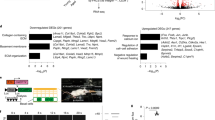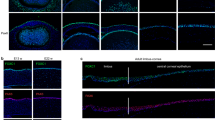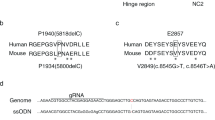Abstract
Loss of tight association between epidermis and dermis underlies several blistering disorders and is frequently caused by impaired function of extracellular matrix (ECM) proteins1,2. Here we describe a new protein in mouse, Fras1, that is specifically detected in a linear fashion underlying the epidermis and the basal surface of other epithelia in embryos. Loss of Fras1 function results in the formation of subepidermal hemorrhagic blisters as well as unilateral or bilateral renal agenesis during mouse embryogenesis. Postnatally, homozygous Fras1 mutants have fusion of the eyelids and digits and unilateral renal agenesis or dysplasia. The defects observed in Fras1−/− mice phenocopy those of the existing bl (blebbed) mouse mutants3,4, which have been considered a model for the human genetic disorder Fraser syndrome5,6. We show that bl/bl homozygous embryos are devoid of Fras1 protein, consistent with the finding that Fras1 is mutated in these mice6. In sum, our data suggest that perturbations in the composition of the extracellular space underlying epithelia could account for the onset of the blebbed phenotype in mouse and Fraser syndrome manifestation in human.
This is a preview of subscription content, access via your institution
Access options
Subscribe to this journal
Receive 12 print issues and online access
$209.00 per year
only $17.42 per issue
Buy this article
- Purchase on Springer Link
- Instant access to full article PDF
Prices may be subject to local taxes which are calculated during checkout






Similar content being viewed by others
Accession codes
References
Bruckner-Tuderman, L. & Bruckner, P. Genetic diseases of the extracellular matrix: more than just connective tissue disorders. J. Mol. Med. 76, 226–237 (1998).
Gustafsson, E. & Fassler, R. Insights into extracellular matrix functions from mutant mouse models. Exp. Cell Res. 261, 52–68 (2000).
Darling, S. & Gossler, A. A mouse model for Fraser syndrome? Clin. Dysmorph. 3, 91–95 (1994).
Lyon, M.F., Rastan, S. & Brown, S.D. Genetic Variants and Strains of the Laboratory Mouse 3rd edn. (Oxford University Press, New York, 1996).
Winter, R.M. Fraser syndrome and mouse “bleb” mutants. Clin. Genet. 37, 494–495 (1990).
McGregor, L. et al. Fraser syndrome and mouse blebbed phenotype caused by mutations in FRAS1/Fras1 encoding a putative extracellular matrix protein. Nat. Genet. 34, ′–′ (2003). [Ed: page numbers for Scambler]
Sadler, J.E. Biochemistry and genetics of von Willebrand factor. Annu. Rev. Biochem. 67, 395–424 (1998).
Roebroek, A.J.M. et al. Cloning and functional expression of Dfurin2, a Subtilisin-like proprotein processing enzyme of Drosophila melanogaster with multiple repeats of a cysteine motif. J. Biol. Chem. 267, 17208–17215 (1992).
Nishiyama, A., Dahlin, K.J., Price, J.T., Johnstone, S.R. & Stallcup, W.B. The primary structure of NG2, a novel membrane-spanning proteoglycan. J. Cell Biol. 114, 359–371 (1991).
Schwarz, E.M. & Benzer, S. Calx, a Na-Ca exchanger gene in Drosophila melanogaster. Proc. Natl. Acad. Sci. USA 94, 10249–10254 (1997).
Hodor, P.G., Illies, M.R., Broadley, S. & Ettensohn, C.A. Cell-substrate interactions during sea urchin gastrulation: migrating primary mesenchyme cells interact with and align extracellular matrix fibers that contain ECM3, a molecule with NG2-like and multiple calcium-binding domains. Dev. Biol. 222, 181–194 (2000).
Spirito, F. et al. Reduced expression of the epithelial adhesion ligand laminin 5 in the skin causes intradermal tissue separation. J. Biol. Chem. 276, 18828–18835 (2001).
Arin, M.J. & Roop, D.R. Disease model: heritable skin blistering. Trends Mol. Med. 7, 422–424 (2001).
McGowan, K.A. & Marinkovich, M.P. Laminins and human disease. Microsc. Res. Tech. 51, 262–279 (2000).
Kuure, S., Vuolteenaho, R. & Vainio, S. Kidney morphogenesis: cellular and molecular regulation. Mech. Dev. 92, 31–45 (2000).
Muller, U. et al. Integrin α8β1 is critically important for epithelial-mesenchymal interactions during kidney morphogenesis. Cell 88, 603–613 (1997).
Willem, M. et al. Specific ablation of the nidogen-binding site in the laminin gamma1 chain interferes with kidney and lung development. Development 129, 2711–2722 (2002).
Tillet, E., Ruggiero, F., Nishiyama, A. & Stallcup, W.B. The membrane-spanning proteoglycan NG2 binds to collagens V and VI through the central nonglobular domain of its core protein. J. Biol. Chem. 272, 10769–10776 (1997).
Slavotinek, A.M. & Tifft, C.J. Fraser syndrome and cryptophthalmos: review of the diagnostic criteria and evidence for phenotypic modules in complex malformation syndromes. J. Med. Genet. 39, 623–633 (2002).
Snyder, P.B., Galanopoulos, V.K. & Kafatos, F.C. Trans-acting amplification mutants and other eggshell mutants of the third chromosome in Drosophila melanogaster. Proc. Natl. Acad. Sci. USA 83, 3341–3345 (1986).
Mouellic, H.L., Lallemand, Y. & Brulet, P. Targeted replacement of the Homeobox gene Hox-3.1 by the Escherichia coli LacZ in mouse chimeric embryos. Proc. Natl. Acad. Sci. USA 87, 4712–4716 (1990).
Acknowledgements
We thank S. Meyer and S. Mahsur for help with the mouse stem cells and morula aggregation; E. Pavlakis for technical assistance; R. Timpl for the antibodies for laminin α5, laminin γ1, agrin and nidogen 1; P. Bonaldo for the collagen VI antibody; L. Bruckner-Tuderman for collagen VII antibodies; H. Krambovitis for the generation of Fras1 antibodies; L. Panagis, C. Dermon and G. Mavrothalassitits for help with the TUNEL assay; A. Argyrokastritis and S. Theophilou for critical reading of the manuscript; and P. Gruss for providing expertise and facilities of his laboratory. This work was supported by a grant from the Greek General Secretariat for Science and Technology and the British Heart Foundation (to P.J.S.).
Author information
Authors and Affiliations
Corresponding author
Ethics declarations
Competing interests
The authors declare no competing financial interests.
Rights and permissions
About this article
Cite this article
Vrontou, S., Petrou, P., Meyer, B. et al. Fras1 deficiency results in cryptophthalmos, renal agenesis and blebbed phenotype in mice. Nat Genet 34, 209–214 (2003). https://doi.org/10.1038/ng1168
Received:
Accepted:
Published:
Issue Date:
DOI: https://doi.org/10.1038/ng1168
This article is cited by
-
Prenatal diagnosis of Fraser syndrome caused by novel variants of FREM2
Human Genome Variation (2020)
-
Whole-genome resequencing analysis of 20 Micro-pigs
Genes & Genomics (2020)
-
AMACO Is a Component of the Basement Membrane–Associated Fraser Complex
Journal of Investigative Dermatology (2014)
-
Segmental and restricted localization pattern of Fras1 in the developing meningeal basement membrane in mouse
Histochemistry and Cell Biology (2013)
-
Identification of two novel CAKUT-causing genes by massively parallel exon resequencing of candidate genes in patients with unilateral renal agenesis
Kidney International (2012)



